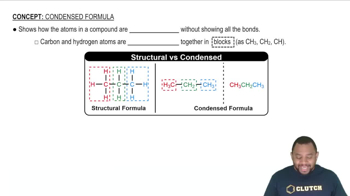The cyanate ion (OCN- ) and the fulminate ion (CNO- ) share the same three atoms but have vastly different properties. The cyanate ion is stable, while the fulminate ion is unstable and forms explosive compounds. The resonance structures of the cyanate ion are explored in Example 10.8. Draw Lewis structures for the fulminate ion—including possible resonance forms— and use formal charge to explain why the fulminate ion is less stable (and therefore more reactive) than the cyanate ion.
Ch.10 - Chemical Bonding I: The Lewis Model

Chapter 10, Problem 98e
Draw the Lewis structure for each organic compound from its condensed structural formula. e. CH3CHO
 Verified step by step guidance
Verified step by step guidance1
Identify the atoms in the condensed structural formula CH3CHO: 1 carbon (C) in CH3, 1 carbon (C) in CHO, 1 oxygen (O), and 4 hydrogens (H).
Determine the connectivity: The CH3 group is connected to the CHO group, indicating a carbon-carbon bond.
Recognize that the CHO group represents an aldehyde functional group, which consists of a carbonyl group (C=O) bonded to a hydrogen atom.
Draw the carbon skeleton: Connect the two carbon atoms with a single bond, then attach the CH3 group to one carbon and the CHO group to the other.
Complete the structure by adding the double bond between the carbon and oxygen in the CHO group, and attach the hydrogen atoms to the appropriate carbon atoms to satisfy the valency of each atom.

Verified video answer for a similar problem:
This video solution was recommended by our tutors as helpful for the problem above.
Video duration:
2mWas this helpful?
Key Concepts
Here are the essential concepts you must grasp in order to answer the question correctly.
Lewis Structures
Lewis structures are diagrams that represent the bonding between atoms in a molecule and the lone pairs of electrons that may exist. They use dots to represent electrons and lines to represent bonds between atoms. Understanding how to draw Lewis structures is essential for visualizing molecular geometry and predicting reactivity.
Recommended video:
Guided course

Lewis Dot Structures: Ions
Condensed Structural Formula
A condensed structural formula provides a shorthand way of representing the structure of a molecule, showing how atoms are connected without depicting all the bonds explicitly. For example, in CH3CHO, the formula indicates that there are two carbon atoms, with one being part of a carbonyl group (C=O) and the other connected to three hydrogens, which helps in determining the arrangement of atoms in the Lewis structure.
Recommended video:
Guided course

Condensed Formula
Valence Electrons
Valence electrons are the outermost electrons of an atom and are crucial for forming bonds with other atoms. The number of valence electrons determines how atoms will bond and the overall structure of the molecule. In drawing Lewis structures, it is important to account for the total number of valence electrons available from all atoms involved to ensure accurate representation of the molecule.
Recommended video:
Guided course

Transition Metals Valence Electrons
Related Practice
Textbook Question
Textbook Question
Draw the Lewis structure for each organic compound from its condensed structural formula. b. CH3OCH3
Textbook Question
Draw the Lewis structure for each organic compound from its condensed structural formula. c. CH3COCH3
Textbook Question
Use Lewis structures to explain why Br3- and I3- are stable, while F3- is not.
